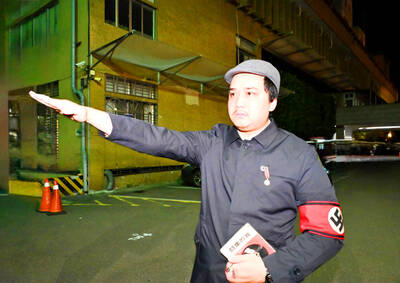In a few years, visitors could pass through unmanned immigration booths following instructions given by smiling robots when they step off the plane at Taiwan’s international airports, National Immigration Agency (NIA) -Director--General Hsieh Li-kung (謝立功) said yesterday.
The first unmanned immigration inspection booths were installed on Tuesday at Shueitou Pier (水頭碼頭) in Kinmen County, from which ferries depart to Xiamen, China.
“At this point, automatic immigration inspection booths have been installed only at Shueitou Pier, and are open only to [Republic of China (ROC)] nationals,” Hsieh told the Taipei Times during a telephone interview. “We plan to install the system at Taiwan Taoyuan International Airport next month — but only for [ROC] nationals as well.”
Passing through immigration checks will be like going through a subway station ticket gate.
“Before using the system, you need to register yourself with two government-issued photo IDs, such as a passport, national ID card or National Health Insurance card, at a machine and have your picture taken there,” he said. “The registration process takes no more than two minutes, then you can scan your passport to pass through the first gate and then have your face scanned by the machine to pass through the second gate before going to the boarding gates.”
Hsieh said that if everything goes smoothly, foreign nationals would also be able to use the system by the end of next year or the year after.
After developing the system, Hsieh said he had another idea after visiting the lab of National Taiwan University electrical engineering professor Luo Ren-chuan (羅仁權), a pioneer in developing robots in Taiwan.
At Luo’s lab, Hsieh met with advanced robots “Monica,” “Luo Guide” and “Luo Head.”
Monica is able to walk, find her own way, record and store images, and greet people by talking; Luo Guide is able to understand spoken directions, search for books in the bookshelf and deliver documents, while Luo Head has a face modeled after a 27-year-old Albert Einstein and, with 36 micromotors, can imitate human facial expressions.
“We’re also looking into the possibility of bringing professor Luo’s robots into the nation’s major international airports,” Hsieh said. “We’re not planning to make robots immigration inspectors, but we’ll use them as guides to greet visitors and give them a surprise, while also showcasing Taiwan’s technological achievements.”

INVESTIGATION: The case is the latest instance of a DPP figure being implicated in an espionage network accused of allegedly leaking information to Chinese intelligence Democratic Progressive Party (DPP) member Ho Jen-chieh (何仁傑) was detained and held incommunicado yesterday on suspicion of spying for China during his tenure as assistant to then-minister of foreign affairs Joseph Wu (吳釗燮). The Taipei District Prosecutors’ Office said Ho was implicated during its investigation into alleged spying activities by former Presidential Office consultant Wu Shang-yu (吳尚雨). Prosecutors said there is reason to believe Ho breached the National Security Act (國家安全法) by leaking classified Ministry of Foreign Affairs information to Chinese intelligence. Following interrogation, prosecutors petitioned the Taipei District Court to detain Ho, citing concerns over potential collusion or tampering of evidence. The

‘FORM OF PROTEST’: The German Institute Taipei said it was ‘shocked’ to see Nazi symbolism used in connection with political aims as it condemned the incident Sung Chien-liang (宋建樑), who led efforts to recall Democratic Progressive Party (DPP) Legislator Lee Kun-cheng (李坤城), was released on bail of NT$80,000 yesterday amid an outcry over a Nazi armband he wore to questioning the night before. Sung arrived at the New Taipei City District Prosecutors’ Office for questioning in a recall petition forgery case on Tuesday night wearing a red armband bearing a swastika, carrying a copy of Adolf Hitler’s Mein Kampf and giving a Nazi salute. Sung left the building at 1:15am without the armband and apparently covering the book with a coat. This is a serious international scandal and Chinese

Seventy percent of middle and elementary schools now conduct English classes entirely in English, the Ministry of Education said, as it encourages schools nationwide to adopt this practice Minister of Education (MOE) Cheng Ying-yao (鄭英耀) is scheduled to present a report on the government’s bilingual education policy to the Legislative Yuan’s Education and Culture Committee today. The report would outline strategies aimed at expanding access to education, reducing regional disparities and improving talent cultivation. Implementation of bilingual education policies has varied across local governments, occasionally drawing public criticism. For example, some schools have required teachers of non-English subjects to pass English proficiency

NEGOTIATIONS: The US response to the countermeasures and plans Taiwan presented has been positive, including boosting procurement and investment, the president said Taiwan is included in the first group for trade negotiations with the US, President William Lai (賴清德) said yesterday, as he seeks to shield Taiwanese exporters from a 32 percent tariff. In Washington, US Trade Representative Jamieson Greer said in an interview on Fox News on Thursday that he would speak to his Taiwanese and Israeli counterparts yesterday about tariffs after holding a long discussion with the Vietnamese earlier. US President Donald Trump on Wednesday postponed punishing levies on multiple trade partners, including Taiwan, for three months after trillions of US dollars were wiped off global markets. He has maintained a 10 percent